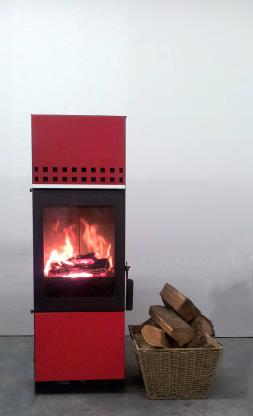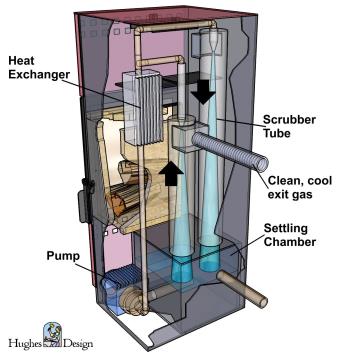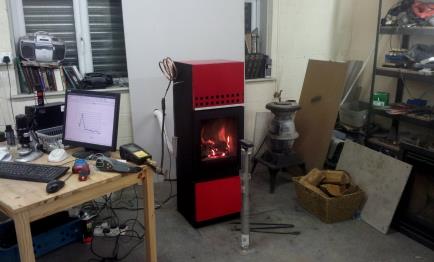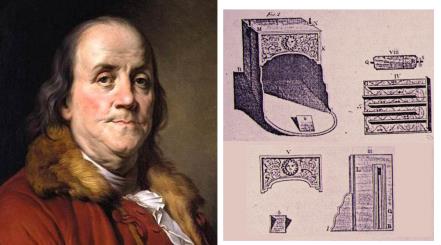

|
|
|
|
The Hughes Condensing Stove- fire without smoke An experimental demonstration stove which burns ordinary logs, makes no smoke, needs no chimney. It's greenhouse gas neutral and almost 100% efficient, now under development in conjunction with the Nimbus Centre at the Cork Institute of Technology... http://nimbus.cit.ie/   THE EXPERIMENT This page is about an experimental wood stove designed and built by Hughes Design Ltd in the UK. It works, but there is a long way to go before it could be anything like a practical product WHY WOOD IS GOOD Wood grows, so it is renewable for ever, and burning it can never emit more carbon gases than the tree itself took in when it was alive, so wood is the greenhouse-neutral fuel. Wood accounts for about 14% of Europe's domestic heating, (but only about 1% in the UK) and is expected to become the largest single source of renewable fuel.  REALLY 100% EFFICIENT? No, not quite. The Hughes Condenser Stove captures about 97% of the heat energy in the wood. Compare that to the, say, 35% for a power station, 27% for a car, or, at very best, 70% for an ordinary wood stove. It means the same heat for about ½ or 1/3 less fuel. WHY SMOKE MATTERS Smoke is just little tiny specks of fuel which haven't properly burned. It isn't just nasty to look at, smoke is very, very poisonous. The Hughes Condenser doesn't emit any smoke, which means it doesn't need a chimney. This matters a lot, not just because you can fit it anywhere and save the cost of a chimney, but because smokes are mutagenic and possibly contribute to a quarter of a million deaths each year in Europe alone. WHERE CAN I GET ONE? The Hughes Condenser Stove is built and working, but it is still a long, long way from being a production product. Copies are being manufactured for trials, but don't expect them to be in the shops by next week. HOW IT WORKS At the back of this stove is a slim tube down which water is sprayed at high velocity, this creates a negative pressure draught which sucks the smoke and waste gases from the fire into the tube. The fast-moving water droplets collide with smoke particles and carry them down to a settling tank, where they form a scum, which is skimmed off the top and dribbled into the drains. This technique, called a 'wet scrubber', is not new, it is widely used to remove smoke and grit from industrial chimneys. What has been tricky has been miniaturising it. The problem is that in order to knock out smoke, the water has to be jetted at a very high velocity, and that generates high pressure, a pressure far too high for a domestic stove to work safely or effectively. The ingenuity here has been to use not one but two scrubber tubes, working in opposite directions relative to the gas flow. So the pressures they generate partly cancel each other out, leaving just enough (about 10 Pascals) for a domestic stove to work perfectly, at the same time as having double the smoke-scrubbing power.  EFFICIENCY There is a practical limit to how efficient an ordinary stove can be. Although curiosities of the European test procedure can show claimed efficiencies of 80-90%, around 62% is more usual, with the absolute maximum being about 75%. It is possible to burn wood with almost perfect efficiency on an ingeniously-designed conventional stove, but what isn't possible is to capture all the heat it produces. There are two reasons for this; First, a certain amount of heat must be lost into the chimney so that the gases in there are less dense and so less pulled-down by gravity than the surrounding air. It is this 'Chimney Effect' which makes sure the (poisonous) smoke and waste gases are drawn out to the the atmosphere and that fresh oxygen is drawn into the stove at a rate sufficient to make it burn at the 'unnaturally' high temperature needed to break-down smoke and potential pollutants. The second reason is that solid fuels contain a lot of water. Even very dry wood can be 20% water - about a cupful in every log - and the flue gas must be kept hot enough all the way along in order to prevent this moisture condensing out. If it partially condenses it produces a sticky, very acid, and very corrosive tar which rapidly eats into or blocks flue-ways. In the Hughes Condensing Stove the water jet generates the draught, so no heat is needed for that, and the whole flue gas is completely condensed, producing merely slightly dirty water rather than tar. Most of the heat normally lost into the chimney is here captured by the water jet, a simple heat exchanger transfers it to the room. HOW A FAMOUS SCIENTIST GOT IT WRONG  Wood stoves look simple. They're not. Like Bertrand Russell said, they seem "something so simple as not to seem worth stating" which on investigation leads to "something so paradoxical that no one will believe it." Stoves have so far resisted all attempts to usefully describe them mathematically - unlike their gas or oil-fired competitors, or major industrial coal plant, the performance of which can be predicted on paper. We've known the actual efficiency of apparently identical stoves to vary from 17% in one case to 83% in another, with the unskilled eye being very hard-pressed to spot any difference between how they're constructed or even how they appear to burn. Benjamin Franklin thought he could increase the efficiency of wood fires by simply extracting more heat from the waste flue gas, he wrote at length about the simple wisdom of his brilliant idea and produced detailed plans. Fine, until someone actually built one and found that, far from giving more heat from less wood, it barely produced any heat at all, but did make huge clouds of toxic smoke. Franklin gave up on stoves. ANYONE ELSE ON WITH THIS? Getting rid of smoke really matters a lot, let alone efficiency and stuff.. There have been more than four thousand patent applications for devices claiming to reduce smoke from stoves. Recent projects we know of to produce a smokeless stove include... Applied Plasma Physics in Denmark http://www.app.no The Institute for Chemical Technology in Germany http://www.combustion.org.uk/ECM_2009/P810026.pdf The Ultralowdust Consortium http://www.ultralowdust.eu Bios Bioenergiesysteme in Austria www.bios-bioenergy.at Windhager Heating Equipment www.windhager.com The Institute for Process and Particle Engineering at the University of Graz www.ippt.tugraz.at The Technology Support Centre of the Government of Bavaria www.tfz.bayern.de The University of Karlsruhe www.eifer.uni-karlsruhe.de The Wuppertal Climate and Energy Institute www.wupperinst.org RuffKat in Germany http://www.ruff-kat.de/cms/front_content.php Hammon Corporation in the USA http://www.hamonusa.com/hamonresearchcottrell/products/esp The Supra Company in France http://www.supra.fr  Hughes Design Ltd, Denver House, Main St, Winster, Derbyshire DE4 2DH glynhughes@btinternet.com |
|
MORE FROM BrightStove... Home Condensing Stove Images The Clean Living Fire Email: info@brightstove.com COPYRIGHT and ALL RIGHTS RESERVED: © BrightStove Consortium, 15/06/2020 BUILT WITH WHIMBERRY matrixstats |